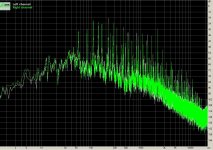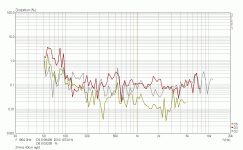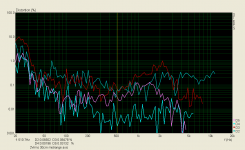Expectations are dangerous. I aviod them at all costs.
EDIT - Peace, you can't possibly be that interested in my enjoyment of 5" drivers as I could care less about your 15" drivers.
No problem ....
My good chap, "percussive energy" is a meaningless term - either the speaker reproduces the frequencies at the SPLs required, or it doesn't - it's as simple as that,...
What you're talking about is the ability of the system to be able to create realistic impact, replicating what real instruments achieve trivially - which the majority of setups can't do, most of the time. I have mentioned many times going to the Sydney hifi show, where there was only one system, on the day, that was able to do that - lots of bluster and thundering from some gear, trying to get something more impressive happening - a bit like the big talker down at the local watering hole ...
For the 9,999th time, getting sound working like it should is a system issue, not a speaker issue. Pro speakers in a solid cabinet is a handy shortcut, but no guarantees - a pricey, ambitious JBL horn system at that show dissolved into standard PA thrash once a bit of volume was asked for ...
Yeah frankie, no such thing ....
The way I see it, no sound being played back is perfect, ever. Even the most pristine audiophile recordings, on the most 'perfectly' optimised system, composed of premium components, is still not 'perfect'. But, the negative qualities in what you're hearing can either be emphasised, highlighted in a very extreme way - or, allowed to blend into the overall presentation such that they don't attract attention to those 'problems'. Think of a beautiful girl, expertly made up, looks radiant in the normal space in which she moves - then, get a very powerful spotlight in darkened room, and move up close to her face, look side on - every blemish, mark, imperfection in the application of the makeup will scream at you, she will look quite "ugly" ...I don't understand. Is TV sound 'perfect' in your experience?
That's the sort of thinking process I use with audio ...
Last edited:
No such thing as "convincing playback", you mean ...?Yeah frankie, no such thing ....
The way I see it, no sound being played back is perfect, ever. Even the most pristine audiophile recordings, on the most 'perfectly' optimised system, composed of premium components, is still not 'perfect'. But, the negative qualities in what you're hearing can either be emphasised, highlighted in a very extreme way - or, allowed to blend into the overall presentation such that they don't attract attention to those 'problems'. Think of a beautiful girl, expertly made up, looks radiant in the normal space in which she moves - then, get a very powerful spotlight in darkened room, and move up close to her face, look side on - every blemish, mark, imperfection in the application of the makeup will scream at you, she will look quite "ugly" ...
That's the sort of thinking process I use with audio ...
Dunno Frankie , in a darken room my spot light wont be on her face ....
In essence, the replay system must add nothing, absolutely nothing - nor take anything away ...Personally, I find that for TV sound, a 'forgiving' speaker is better. However, for component evaluation with the best sources that I can find, then a 'revealing' speaker is best. I need this because I make my living from noting the differences.
I've done experiments, ages ago, that told me if I do everything right to extract the best from ordinary TV sound, that it would be scarily good ... would bowl a lot of people over ...
As an example, we have digital TV background music on a couple of channels - on the older big set, the Aldi, this has an irritating digital 'edge' to it, I can only take a few minutes of listening to it, no matter how layback the recording is. Nothing obviously wrong, it just has that quality about it that bugs a lot of people about how digital sound comes across. But, just bought a super el cheapo, small bedroom TV, again Aldi - hmmm, wonder how the TV radio sounds on this ... surprise, very pleasant - OK, push the treble right up to maximum to emphasise any problems, still sounds good! Pathetic bass and volume, but it gets the musical side of things right ...
There are so many factors in all of this, no simple answers ...
Personally, I find that for TV sound, a 'forgiving' speaker is better. However, for component evaluation with the best sources that I can find, then a 'revealing' speaker is best. I need this because I make my living from noting the differences.
Few years ago I experienced the same thing experienced by every you-know-who in speaker industry. That there is an enjoyable speaker that masks the details, and there is revealing speaker that is not enjoyable. Luckily I found the recipe to get it both enjoyable and revealing
Imagine a speaker that can produce micro nuance of singer's emotion. It is more than just accurate vocal, but also yummy yummy
Looking at note synthesis and how it fails or succeeds points to important issues in perception.
ES
This gets to be fun at slide 39
http://www.davidgriesinger.com/intermod.ppt
Also
http://www.davidgriesinger.com/Acoustics_Today/Pitch, Timbre, Source Separation.pptx
ES
see Griesinger ---- later, gotta go
This gets to be fun at slide 39
http://www.davidgriesinger.com/intermod.ppt
Also
http://www.davidgriesinger.com/Acoustics_Today/Pitch, Timbre, Source Separation.pptx
I tried that organ sample on bcarso's PC monitors, and this is where quality comes into the picture
Goodby with that.
You frame the wrong subject.
It is the content of the music that is played through these speakers that don’t go low, so your brain tries to synthesize the lower frequencies but it fails to do it appropriately as there is a lot of low freq that doesn’t come out of the speakers .
As you saw on the waterfall plots I posted earlier, the very low frequencies modulate at different rates from the low frequencies and these at different rates from the mid frequencies.
The synthesized in your brain fundamentals are wandering and assigned a wrong amplitude.
See the attachment below for the FFT of the whole file.
How much energy lives btn 20Hz- 100Hz ?
Notice the relation of the higher harmonics with the peaks below 100Hz.
See the peaks below 20Hz. These are the signatures of modulation.
The left channel distorts more as it is hotter than the right channel.. It reaches –3.0dBDFS at the frequencies that your speakers boost (100-200Hz)
You say that it is the whole audio system that matters. Yes but you fail to include the music content into this system.
George
PS. Build a set of LP electrical filters which will fit the acoustical LF behaviour of your PC speakers in freq, slope and Q. Play this organ file through these electrical filters with large speakers and notice what you hear.
George
Attachments
Last edited:
Personally, I find that for TV sound, a 'forgiving' speaker is better. However, for component evaluation with the best sources that I can find, then a 'revealing' speaker is best. I need this because I make my living from noting the differences.
The problem with much TV sound is that on the low end, there is no standard. Also, I suspect much recorded sound to be monitored on speakers without much bass extension. Therefore, you need a way to cut excessive bass when listening to tv on full range speakers.
Another problem is with voice registration. Sibilance, room sound, bad mic's, you name it, everything bad happens.
Still, I prefer to listen to all this on good (revealing) speakers, because 'forgiving' speakers also tend to decrease intelligibility.
I appreciate what you're saying, George, but again note I am emphasising that this type of musical signal will be such to expose the limitations of this type and quality of speaker.
The left channel problem is 100% an issue with my particular examples of these speakers - I've generated ramped, pure 100Hz tones, and listened to how the speakers handled this test signal. Excess distortion harmonics produced by these drivers at the bottom of their useful range will do plenty of damage to the tonality of the organ note, let alone modulation of sub-100Hz fundamentals being inaudible.
I'm not quite sure what you mean by "you fail to include the music content" ...
Those electrical filters could be largely mimicked by doing software equalisation of the sound file to roll off the bass content. And I feel it still would differ because the superior, larger drivers would have quite different harmonic distortion behaviours in the 100-200Hz range, compared to the PC units ...
The left channel problem is 100% an issue with my particular examples of these speakers - I've generated ramped, pure 100Hz tones, and listened to how the speakers handled this test signal. Excess distortion harmonics produced by these drivers at the bottom of their useful range will do plenty of damage to the tonality of the organ note, let alone modulation of sub-100Hz fundamentals being inaudible.
I'm not quite sure what you mean by "you fail to include the music content" ...
Those electrical filters could be largely mimicked by doing software equalisation of the sound file to roll off the bass content. And I feel it still would differ because the superior, larger drivers would have quite different harmonic distortion behaviours in the 100-200Hz range, compared to the PC units ...
I appreciate what you're saying, George, but again note I am emphasising that this type of musical signal will be such to expose the limitations of this type and quality of speaker.
I wouldn’t object on the torture but you have concluded that the drivers have not been built sufficiently well.
“Quality” of a manufactured product is conformance to design specifications.
Design specifications are set according to the intended use for this type of speakers and the target market segment.
Building to higher specifications will raise the cost/price and may throw the product outside of the targeted market segment.
Ironically, that will be a failure attributed to inefficient quality control.
What one technically minded person has the right to complain about is the lack of detailed/conclusive published specifications.
Yes, the “Freq Response (-10dB): 44Hz-20KHz” and the “Subwoofer-Amplifier Output Power: 20W RMS” are hazy but it is what one finds on this type of speakers.
(I guess you are talking of this set):
Harman Kardon - SoundSticks III - 2.1 - Channel Multimedia Sound System
I'm not quite sure what you mean by "you fail to include the music content" ...
This set will play well, loud enough and balanced with music material that it’s energy content is located within the power bandwidth of the speaker set.
We conclude on the loudness of a musical piece by the loudness of it’s mid freq section (A-weighing) and we perceive a sound as balanced, based on a symmetry of it’s freq response around the ~ 800Hz point (on logarithmic freq scale).
I've generated ramped, pure 100Hz tones, and listened to how the speakers handled this test signal. Excess distortion harmonics produced by these drivers at the bottom of their useful range will do plenty of damage to the tonality of the organ note, let alone modulation of sub-100Hz fundamentals being inaudible.
Which units are distorting the most with that test signal? These at the satellites or at the sub?
Did you check if it is the embedded amplifier that is overdriven/distorts and not the drivers?
Have you performed freq response sweeps on this set? At what output dB levels?
George
Last edited:
Have a look on this !!!
Physicists design acoustically invisible walls - physicsworld.com
George
Physicists design acoustically invisible walls - physicsworld.com
Physicists design acoustically invisible walls
Same for sound
Now, Sam Lee of Yonsei University in Seoul, South Korea, Oliver Wright of Hokkaido University, Japan, and colleagues have produced an analogue of Engheta's metamaterial for sound waves. Just as electromagnetic waves propagate as vibrations in a material's electromagnetic field, sound waves travel as physical oscillations of the atoms. Sound waves cannot pass through a rigid barrier because the atoms cannot oscillate. Making tiny holes in the barrier will barely increase transmission. Lee explains that if, for example, the holes make up 3% of the volume of the barrier, "to ensure continuous volume flow across the barrier, the air in the holes has to move 30 times faster than the air outside the wall. The inertia of the air does not allow for the huge accelerations needed for motion of such amplitude." To solve this problem, the researchers needed the air in the holes to have almost zero inertia – the acoustic equivalent of an ENZ material.
They achieved this, paradoxically, by covering the holes with a thin membrane of shop-bought kitchen cling film. With the tension tuned so that the membrane's resonant frequency is the same as the frequency of the incident waves, the membrane's resonance amplifies its oscillations. The resonance moves the air through the holes as though the air has no inertia, allowing it to move in response to even a small displacement and sucking almost all the energy of the incident waves through the barrier.
Invisible barriers
On the other side of the barrier, Huygens' principle dictates that each hole produces spherical wavefronts. The separation between the holes is much less than the wavelength of the sound, which means the interference pattern of the waves reconstructs the plane wave in much less than one wavelength and the barrier is effectively invisible to the propagating waves.
The researchers tested their acoustic-metamaterial design by placing an acrylic barrier perforated with four small holes in a tube. Loudspeakers producing waves of a single frequency were placed at one end and the researchers measured the intensity of the waves on either side of the barrier. The results were remarkable – they found, for example, that with the barrier perforated by bare holes, only 9% of the waves' energy was transmitted. With a membrane placed over the holes, this proportion jumped to 81%. The metamaterial worked just as well when placed at an oblique angle to the incident wavefronts.
Ebbese, who was not involved in this work, views the result as a significant contribution to acoustics with numerous potential uses. "They're talking about transmission, but in the same way you can also block waves at other frequencies by adding this membrane," he says, listing noise filters as one application where this could be useful.
George
Have a look on this !!!
George
Did you catch the single frequency part? Like a plane of acoustic series LC's
Did you catch the single frequency part? Like a plane of acoustic series LC's
Yes. It refers to the test set-up they did:
The researchers tested their acoustic-metamaterial design by placing an acrylic barrier perforated with four small holes in a tube. Loudspeakers producing waves of a single frequency were placed at one end…
IMO, the important part is here:
With the tension tuned so that the membrane's resonant frequency is the same as the frequency of the incident waves, the membrane's resonance amplifies its oscillations.
which, again shows the single frequency point. But parts of a “wall” covered with membranes of different tensioning will spread the effect to selected frequencies.
I am just fascinated by the effect of the membrane.
Yes, on first read, it seems like LC acoustic resonance filters. But is it?
the membrane's resonance amplifies its oscillations. The resonance moves the air through the holes as though the air has no inertia, allowing it to move in response to even a small displacement and sucking almost all the energy of the incident waves through the barrier.
George
Last edited:
- Status
- Not open for further replies.
- Home
- Member Areas
- The Lounge
- John Curl's Blowtorch preamplifier part II


